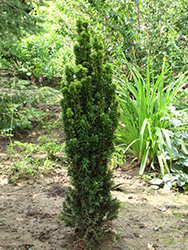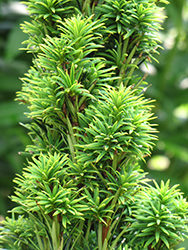Height: 25 feet
Spread: 8 feet
Sunlight:
![]()
![]()
![]()
Hardiness Zone: 7a
Other Names: Common Yew
Description:
A wonderful small evergreen color accent tree with radiant variegated needles of gold and green on a large, pyramidal and spreading form, interesting red berries, has numerous applications, takes pruning well
Ornamental Features
Golden Irish Yew is primarily valued in the landscape for its rigidly columnar form. It has attractive green foliage edged in gold which emerges gold in spring. The ferny sprays of foliage are highly ornamental and turn chartreuse in the fall, which persists throughout the winter. The fruits are showy red drupes displayed from early to late fall.
Landscape Attributes
Golden Irish Yew is a dense evergreen tree with a narrowly upright and columnar growth habit. Its relatively fine texture sets it apart from other landscape plants with less refined foliage.
This is a relatively low maintenance tree, and can be pruned at anytime. It has no significant negative characteristics.
Golden Irish Yew is recommended for the following landscape applications;
- Accent
- Vertical Accent
- Hedges/Screening
- Topiary
Planting & Growing
Golden Irish Yew will grow to be about 25 feet tall at maturity, with a spread of 8 feet. It has a low canopy with a typical clearance of 2 feet from the ground, and is suitable for planting under power lines. It grows at a slow rate, and under ideal conditions can be expected to live to a ripe old age of 120 years or more; think of this as a heritage tree for future generations!
This tree performs well in both full sun and full shade. However, you may want to keep it away from hot, dry locations that receive direct afternoon sun or which get reflected sunlight, such as against the south side of a white wall. It does best in average to evenly moist conditions, but will not tolerate standing water. It is not particular as to soil type or pH. It is highly tolerant of urban pollution and will even thrive in inner city environments, and will benefit from being planted in a relatively sheltered location. Consider applying a thick mulch around the root zone in winter to protect it in exposed locations or colder microclimates. This is a selected variety of a species not originally from North America, and parts of it are known to be toxic to humans and animals, so care should be exercised in planting it around children and pets.
Disclaimer - This resource is provided for informational purposes only and does NOT reflect current availability. Inventory varies seasonally, so we cannot guarantee that every plant will be in stock at all times - please contact your favourite GardenWorks location directly for current availability. It does not include our entire inventory of plants, so be sure to visit GardenWorks to see varieties that may not be represented on this list.


